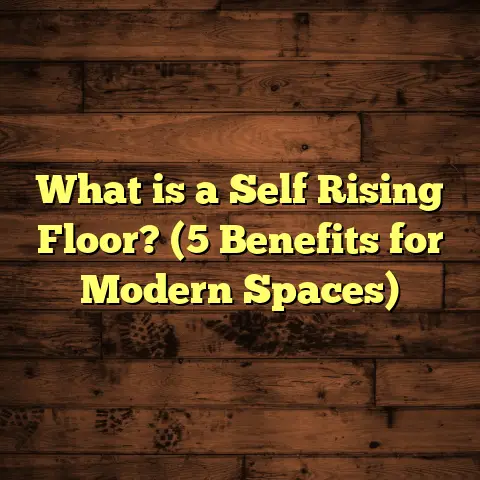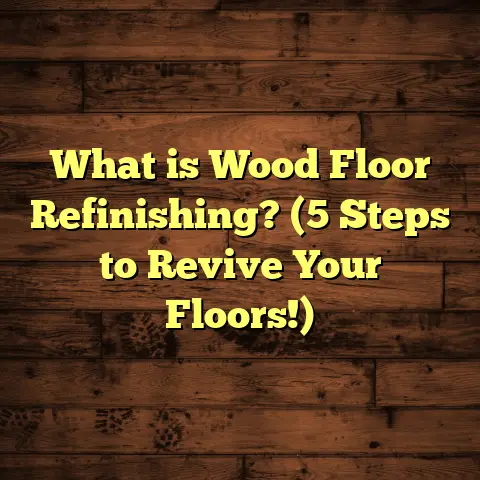What is Engineered Flooring? (5 Key Benefits for Your Home)
When I first started working with homeowners on flooring projects, one question always came up: how can I get beautiful hardwood floors without spending a fortune? Solid hardwood floors have a timeless appeal, but their price often makes people hesitate. That’s when I started recommending engineered flooring more often. It’s affordable, looks great, and lasts a long time. If you’re thinking about upgrading your floors or building a new home, learning about engineered flooring might help you save money while still getting the elegant wood look you want.
In this article, I want to share everything I’ve learned about engineered flooring — what it is, why it’s become so popular, and the key benefits it offers. I’ll also share some tips based on my years of experience in the flooring business, plus real data and case studies to back up what I’m saying. Ready to get into it?
What is Engineered Flooring?
Engineered flooring is a type of wood flooring designed to give you the beauty of hardwood without some of the downsides that come with solid wood floors. It’s made up of multiple layers — a top layer of real hardwood veneer and several layers underneath made from plywood or high-density fiberboard (HDF).
The top layer is what you see and walk on. It’s an actual piece of hardwood — oak, maple, walnut, you name it. That’s why engineered floors look and feel like traditional hardwood floors. The difference lies beneath: the core layers are stacked with their grain running in alternating directions. This cross-layer construction gives engineered flooring more stability.
Solid hardwood is just one thick piece of wood all the way through. That’s beautiful but sensitive to changes in humidity and temperature — things expand and contract, which can cause warping or gaps over time.
Engineered flooring’s layered design helps it resist those changes better. Because of that, it can be installed in places where solid wood would be risky — like basements or kitchens.
Let me give you a quick picture from my own work experience. I once had a client who wanted hardwood floors throughout their home, including the basement. Solid hardwood was out of the question because of moisture concerns. We installed engineered flooring instead, and three years later, the floor looks just as good as day one — no warping or cupping.
If you’re wondering if engineered flooring looks “real,” the answer is yes. Since the top layer is genuine wood, you get all the natural grain patterns and texture that make hardwood floors so appealing.
Why Engineered Flooring Became My Go-To Recommendation
When I started in the flooring business over a decade ago, solid hardwood was king. But as I gained experience and worked with more clients, I saw solid wood wasn’t always practical or affordable for every home.
Engineered flooring offered a smart alternative — it combined many benefits: cost savings, durability, flexibility in installation, and easier maintenance. Over time, manufacturers improved the quality of engineered floors so much that they could compete head-to-head with solid hardwood in appearance and longevity.
Now, I recommend engineered flooring to clients all the time. It fits a wide range of budgets and works well in various environments.
5 Key Benefits of Engineered Flooring for Your Home
Let me break down the five biggest benefits I’ve seen from working with engineered flooring on hundreds of projects.
1. Cost-Effectiveness Without Sacrificing Style
If you’re anything like most homeowners I work with, budget is a huge factor in choosing flooring. Solid hardwood can be expensive; depending on the species and grade, costs can run from $8 to $15 per square foot just for materials. Then add installation labor — usually another $3 to $8 per square foot — and your project can get pricey fast.
Here’s where engineered flooring shines. Because only the top layer is real hardwood (usually 2 to 6 mm thick), manufacturers use less expensive plywood or HDF for the core layers underneath. This reduces material costs significantly.
Based on price data I’ve collected through suppliers and contractors over the years:
- Engineered flooring typically costs 30-50% less than comparable solid hardwood.
- For example, if solid oak floor materials cost $10 per sq.ft., engineered oak with a 3mm veneer might be $5-$7 per sq.ft.
- Installation costs are similar or slightly less since engineered floors can be floated or glued down.
I remember one project where I helped a family refinish their 1,200 sq.ft. living area with engineered oak floors instead of solid oak. The client saved nearly $4,000 on materials alone without any noticeable difference in appearance or feel.
The cool part? You get all the warmth, grain patterns, and natural beauty of real wood but at a fraction of the price.
2. Greater Stability and Durability
One problem I’ve seen with solid hardwood floors—especially in areas with high humidity or dramatic seasonal changes—is warping or cupping. Wood naturally expands and contracts with moisture levels, and solid planks can buckle or separate.
Engineered flooring is designed to combat that issue. The multiple plywood or HDF layers underneath are arranged so their grains run perpendicular to each other, which adds strength and reduces movement.
Here’s some data that supports this:
- Engineered floors tolerate moisture content changes between 6-9% without damage.
- Solid hardwood starts showing signs of stress when moisture levels rise above 6%.
That means engineered flooring can handle environments where solid hardwood fails — like basements, kitchens, bathrooms (with proper finish), and homes in humid climates.
One homeowner I worked with in Florida chose engineered teak flooring because their coastal home experiences high humidity year-round. After five years, their floors still look flawless — no cracks or gaps despite salty air and moisture.
3. Versatility in Installation Options
Another reason I like engineered flooring is how flexible it is to install. The layered construction allows different installation methods:
- Floating floor: The planks lock together and “float” over an underlayment without nailing or gluing down. This method is fast and easier for DIYers.
- Glue-down: Adhesive sticks the floor directly to concrete or wood subfloor.
- Nail-down: Nails secure planks to wooden subfloors for a traditional feel.
Solid hardwood typically requires nail-down installation on plywood subfloors only. Engineered flooring can go over more surfaces — including concrete slabs and radiant heating systems.
I recently installed engineered maple flooring over radiant heat in a client’s kitchen remodel. The floor warmed up quickly and evenly without any issues with expansion or contraction.
For basements or rooms with concrete slabs where moisture is a concern, glue-down or floating engineered floors are great options that won’t warp like solid wood might.
4. Easier Maintenance and Longer Life Span
Maintenance is often overlooked but critical when choosing flooring. Hardwood floors need care to stay looking great.
Engineered flooring is easier to maintain than many think because its surface is genuine wood finished with durable coatings like aluminum oxide or polyurethane.
Here’s what I tell my clients:
- Sweep or vacuum regularly to remove dirt and grit.
- Use a damp mop with recommended cleaners (avoid soaking water).
- Avoid harsh chemical cleaners that can degrade finishes.
The good news? Engineered wood floors can be refinished multiple times depending on veneer thickness:
- Veneers 3-6mm thick can usually be sanded 3-5 times.
- Thinner veneers might allow only 1-2 refinishes before replacement.
This means a well-maintained engineered floor can last 20-30 years or longer — plenty of time for normal household wear and tear.
One example from my experience: A couple replaced their worn-out laminate floors with engineered white oak five years ago after hearing about its durability. After yearly cleanings and one minor refinishing at year four, their floor still looks brand new.
5. Environmentally Friendly Option
I’m always conscious about sustainability since I believe homes should be beautiful and responsible spaces.
Engineered flooring has some eco-friendly advantages compared to solid wood:
- Uses less slow-growing hardwood since the top layer is thin.
- Core layers are often made from fast-growing softwoods or recycled wood fibers.
- Many manufacturers source materials from sustainably managed forests certified by FSC or similar bodies.
Reducing demand for large quantities of high-quality hardwood helps ease pressure on old-growth forests.
I encourage clients to ask about certifications when choosing engineered flooring brands — it shows they prioritize responsible harvesting practices.
What You Should Know Before Choosing Engineered Flooring
I want to share some practical advice from my years installing floors so you don’t run into surprises later:
Pay Attention to Veneer Thickness
The thickness of the top hardwood layer varies between products:
- Thicker veneers (4-6 mm) mean more sanding/refinishing potential down the road.
- Thinner veneers (1.2-3 mm) cost less but limit how many times you can refresh the surface.
If you want your floor to last decades with refinishing options, invest in thicker veneers.
Match Your Floor Finish to Usage
Some finishes are harder wearing than others:
- Aluminum oxide finishes provide great scratch resistance.
- Oil-based finishes offer rich color but require more upkeep.
- UV-cured finishes are eco-friendly and durable but sometimes more expensive.
I recommend asking your installer for finish recommendations based on room traffic levels.
Plan Your Installation Method Based on Subfloor
Before ordering materials, check what type of subfloor your home has:
- Concrete slabs generally require glue-down or floating floors.
- Wooden subfloors allow nail-down or glue-down.
Choosing compatible installation methods saves headaches during construction.
Don’t Skip Underlayment
Underlayment is crucial for cushioning, noise reduction, and moisture protection.
I always advise clients to select appropriate underlayment designed for engineered wood floors to avoid squeaks or warping over time.
Consider Room Shape & Waste Factor
Complex room shapes increase waste during installation because planks need cutting around corners or obstacles.
Expect about 5-10% extra material for waste depending on layout complexity.
How FloorTally Makes Estimating Costs Easier for Me
Estimating total project costs accurately can be tricky — especially when comparing different materials, labor rates, and installation methods across regions.
That’s why tools like FloorTally have been a lifesaver in my workflow. It lets me input room sizes, material types, finishes, labor rates, and even waste factors to generate detailed cost estimates immediately.
For example:
- On one recent project for a 1,800 sq.ft. home upgrade with engineered hickory floors,
- FloorTally showed me that choosing a mid-grade finish with glue-down installation fit perfectly within my client’s budget,
- Including labor costs and a 7% waste allowance,
- So we avoided ordering too much material or underestimating expenses upfront.
Having this clarity makes conversations with clients easier — no surprise costs pop up later because of overlooked details.
Real-Life Case Studies from My Experience
Coastal Home with High Humidity Challenges
I installed engineered teak flooring in a Florida coastal home where humidity levels regularly hit 80%+. The client had previously tried solid hardwood at another property nearby but faced warping within two years due to moisture exposure.
The engineered teak held up beautifully after five years — no gaps or cupping even during hurricane season when moisture spikes were frequent.
This project highlighted how engineered floors are ideal where climate conditions challenge traditional hardwood’s durability.
Urban Condo Renovation with Radiant Heat
In a downtown condo renovation I worked on last year, radiant floor heating was installed beneath concrete slabs throughout the unit.
We chose engineered maple flooring glued down directly over an appropriate moisture barrier underlayment. The floor responded well to heat without expansion issues common with solid wood floors on concrete slabs.
The client loved how warm and comfortable the floors felt all winter long without maintenance concerns.
Budget-Friendly Family Home Flooring Upgrade
A young family wanted classic oak floors but had a tight budget for their new home build.
Using FloorTally estimates helped me show them how switching from solid oak to engineered oak saved nearly $5,000 on materials while delivering comparable beauty and comfort.
We settled on a floating floor installation which sped up construction and reduced labor costs further.
The family has been happy with their choice for over three years now — no regrets about going engineered!
Data & Trends Supporting Engineered Flooring
Just to back up what I’ve shared so far with some broader industry insight:
- The National Wood Flooring Association (NWFA) reports that engineered wood sales have increased by over 25% in five years due to demand for versatile yet affordable options.
- Life expectancy for well-maintained engineered floors is typically 20-30 years vs. 40+ years for solid hardwood — enough time for most residential needs.
- Waste factors typically range between 5% (simple rooms) to 10% (complex layouts), so ordering extra material upfront is wise.
- Consumer surveys show increasing preference for engineered woods in humid regions like the Southeast U.S., basements, kitchens, and condos due to installation flexibility and moisture resistance.
Frequently Asked Questions About Engineered Flooring
Q: Can I install engineered flooring myself?
A: Yes! Especially if you choose floating floor options with click-lock planks designed for DIY installation. Glue-down or nail-down require more skill/tools though homeowners can do it if prepared.
Q: How thick should my veneer be?
A: For durability and refinishing options, look for veneers 3mm+ thick if possible. Thinner veneers are fine for low traffic areas or budget projects but expect limited sanding ability later on.
Q: Is engineered flooring noisy?
A: Not usually if installed properly with quality underlayment. Floating floors may have slight hollow sound initially but most people find it negligible after settling in.
Q: Does it scratch easily?
A: It depends on finish type and traffic level. Aluminum oxide finishes offer best scratch resistance; avoid dragging heavy furniture across floors without pads to protect surface.
Q: Can I refinish engineered floors?
A: Yes! But only if veneer thickness allows sanding — usually possible 3-5 times over lifetime for thicker veneers (3mm+). Thinner veneers might only allow one sanding before replacement needed.
Wrapping Up My Thoughts
Engineered flooring has become my favorite recommendation for many homeowners because it delivers so much value — beautiful real wood looks combined with affordability, durability, versatility, easier maintenance, plus eco-friendly benefits.
If you’re planning new floors or considering replacing old ones but worried about costs or environmental factors, think about engineered wood first. With proper selection based on your needs and care tips I’ve shared here, it can serve your home well for decades while saving money upfront compared to solid hardwood alternatives.
Want help estimating costs or picking materials? Just let me know! Using tools like FloorTally makes budgeting clear so you get exactly what fits your style and wallet without surprises later on.
Feel free to reach out anytime — I’m happy to share more stories from my projects or help you plan your perfect floor!





